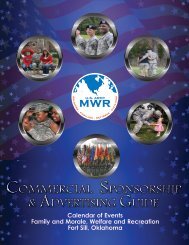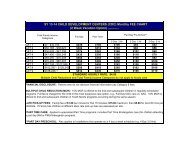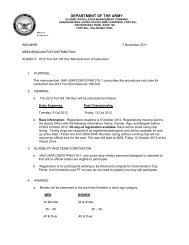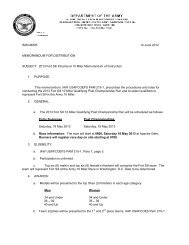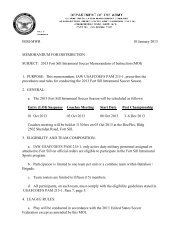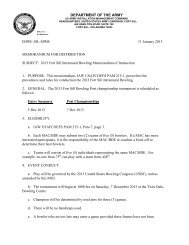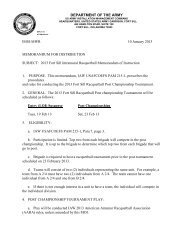Preparing and Managing Correspondence - Fort Sill MWR
Preparing and Managing Correspondence - Fort Sill MWR
Preparing and Managing Correspondence - Fort Sill MWR
You also want an ePaper? Increase the reach of your titles
YUMPU automatically turns print PDFs into web optimized ePapers that Google loves.
Chapter 6<br />
Authority Lines, Signatures, <strong>and</strong> Signature Blocks<br />
Section I<br />
Delegation of Authority<br />
6–1. Delegation of signature authority<br />
a. Delegation. The heads of organizations may allow others (including noncommissioned officers <strong>and</strong> civilian<br />
employees) to sign for them. In doing so, however, they are delegating authority, not responsibility. The comm<strong>and</strong>er of<br />
an organization or the head of an agency or office is responsible for the activities of his or her comm<strong>and</strong>, agency, or<br />
office. Comm<strong>and</strong>ers <strong>and</strong> heads of agencies or offices cannot share or delegate this responsibility. Comm<strong>and</strong>ers <strong>and</strong><br />
heads of agencies or offices—to include all echelons of comm<strong>and</strong> <strong>and</strong> activities—may delegate their signature<br />
authority to their subordinates (including noncommissioned officers <strong>and</strong> civilian employees). Comm<strong>and</strong>ers may also<br />
authorize principal staff officers to decide who signs comm<strong>and</strong> correspondence.<br />
b. Methods of delegation. Principal staff officers who exercise their authority in the normal course of their assigned<br />
duties do not require written delegation of authority (for example, the Deputy Chief of Staff for Personnel (DCSPER)<br />
signing correspondence relating to personnel policy or the Director of Engineering <strong>and</strong> Housing signing correspondence<br />
relating to engineer activities policy). If necessary, the comm<strong>and</strong>er may withhold signature authority even for<br />
these staff officers. Delegation of signature authority in other cases needs to be in writing <strong>and</strong> accompanied by an<br />
explanation of the material for which the comm<strong>and</strong>er has approved signature delegations. Individuals delegated<br />
signature authority will use their own signature blocks <strong>and</strong> titles (such as tables of distribution <strong>and</strong> allowance (TDA) or<br />
table of organization <strong>and</strong> equipment (TOE) position title).<br />
(1) Delegation may be in any written form considered appropriate by the comm<strong>and</strong>er or head of an agency or office.<br />
It could be a memor<strong>and</strong>um or local form designed for this purpose. Any delegation of authority is to the individual <strong>and</strong><br />
not to the job title or description. Written delegation should address or contain the following:<br />
(a) A statement that the comm<strong>and</strong>er or head of the agency or office retains the authority to cancel or withdraw<br />
delegated authority at any time.<br />
(b) A statement that upon change of comm<strong>and</strong> or change of the agency head or office, all delegations are subject to<br />
review by the new comm<strong>and</strong>er who may choose to cancel or change some delegations.<br />
(2) Delegated authority is automatically canceled upon the retirement, change of duties, or change of position of the<br />
individual who has delegated authority.<br />
(3) Some circumstances may require an oral delegation. When this is the case, follow up in writing as soon as<br />
possible.<br />
6–2. Delegation of authority line<br />
a. General. When a person other than the comm<strong>and</strong>er signs military correspondence, an authority line is necessary<br />
to indicate that the correspondence expresses the will of the comm<strong>and</strong>er. Use an authority line when correspondence<br />
containing policy matters, comm<strong>and</strong> decisions, official recommendations, <strong>and</strong> tasking actions is signed for the comm<strong>and</strong>er<br />
or head of an agency by an authorized individual (an authorized individual is one who has proper authority to<br />
sign for the comm<strong>and</strong>er or agency head).<br />
b. Exceptions. Omit the authority line on letters <strong>and</strong> on correspondence prepared for the personal signature of the<br />
head of a comm<strong>and</strong>, agency, or office. Also, omit it when there is a m<strong>and</strong>atory phrase in the text, such as—<br />
(1) “The Secretary of the Army directs...”<br />
(2) “The Comm<strong>and</strong>er desires...”<br />
(3) “The Comm<strong>and</strong>ing Officer...” or “the Comm<strong>and</strong>er... has asked that I inform you...”<br />
c. Placement. When used, place the authority line as shown in the figures of chapter 2 <strong>and</strong> type it in uppercase<br />
letters.<br />
d. Omissions. When unsure about which authority line to use, omit it <strong>and</strong> later type or stamp it in when the<br />
correspondence is signed.<br />
e. Delegated by Secretary of the Army. Only the Secretary of the Army can approve the signature delegation of “BY<br />
ORDER OF THE SECRETARY OF THE ARMY.”<br />
f. Delegated to the subordinate. When a subordinate has signature authority, the subordinate will use an authority<br />
line to show for whom he or she is signing. For examples see appendix E (figs E–1 through E–14).<br />
(1) FOR THE...: If an agency or staff head delegates signatures in his or her area of responsibility, that is the<br />
authority line to use. For example see figure E–4.<br />
(2) FOR THE COMMANDER: Documents signed by the comm<strong>and</strong>er’s staff normally use this authority line when<br />
the document pertains to comm<strong>and</strong> policy. For examples see figures E–2 <strong>and</strong> E–6.<br />
(3) FOR THE COMMANDER IN CHIEF: Use on correspondence signed by an authorized representative of a<br />
comm<strong>and</strong>er who bears the title “Comm<strong>and</strong>er in Chief.”<br />
g. Delegated with qualification. There are sometimes qualifications on delegated signature authority. A specific<br />
AR 25–50 • 3 June 2002<br />
47




